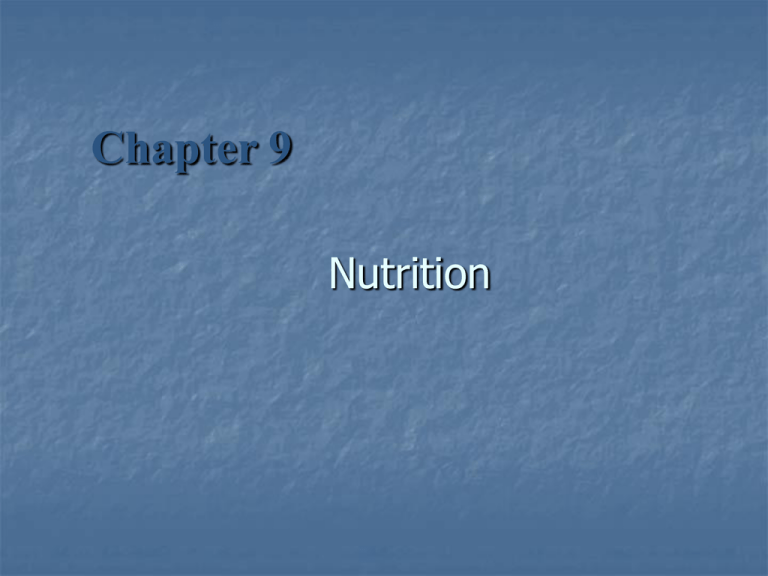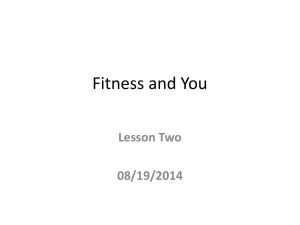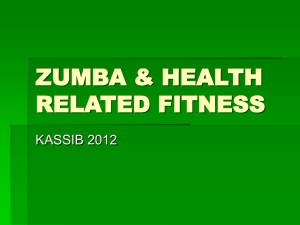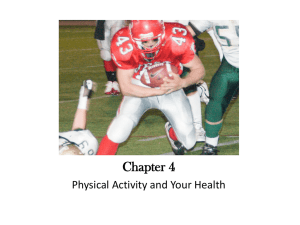Mrs. Carroll`s Fitness Notes (PowerPoint)
advertisement

Chapter 9 Nutrition Nutrients Nutrients are substances that help with body processes, growth, repair of cells, and provides energy Protein Fat Carbohydrates Water Vitamins Minerals A Calorie is a unit of energy produced by food and used by the body Protein A protein is a nutrient needed for growth and repair Proteins form part of every cell in the body and make up more than 50% of total body weight The following are additional information on protein: Kcal value – 4 Kcal/gram Types – complete/incomplete Basic breakdown – amino acids Sources: Meat, chicken, tuna, dried beans, eggs, nuts Carbohydrates Carbohydrates are the main source of energy for the body They include sugars, starches, and fiber The following is additional information on carbohydrates: Kcal value – 4 Kcal/gram Types – single/complex Basic breakdown – glucose Sources: Bread, wheat, rice, pasta, macaroni noodles, cereal, oatmeal Fiber is part of grains and plants that cannot be digested Fats A fat is a nutrient that provides energy and helps the body store and use vitamins The following is additional information on fats: Kcal value – 9 Kcal/gram Types – saturated/unsaturated Basic breakdown – fatty acids Sources: Ice cream, milk, cheese, butter, margarine, yogurt, meat, egg yolks, corn oil Cholesterol is a fat-like substance made by the body and found in certain foods Vitamins A vitamin is a nutrient that helps the body use carbohydrates, proteins, and fats The following is additional information on vitamins: Function – assists with body processes Kcal value – 0 (does not supply energy) Types – water (BC) and fat soluble (ADEK) Vitamins Vitamin A – night vision, bone formation Riboflavin – Appetite Sources: carrots, sweet potatoes Sources: Nuts, cereals, peas, beans Ascorbic acid – resist infection, strengthen blood vessels Sources: Oranges, limes, tomatoes Minerals A mineral is a nutrient that assists with chemical reactions in the body The following is additional information on minerals: Kcal value – 0 (does not supply the body with energy) Types Macro minerals (required in larger amounts) Trace minerals (needed in small amounts) Iron, Calcium, and Sodium are considered 3 important minerals Minerals Calcium – strong bones, teeth, heartbeat Chlorine – aids in digestion, keeps body limber Sources: table salt, seafood Iron – forms red blood cells, growth, prevents fatigue Source: table salt Iodine – energy, mental alertness, growth Sources: milk, cheese, cottage cheese Sources: Oatmeal, red meat, liver Magnesium – fights depression, insomnia, nervousness Sources: dark green veggies, apples Water Water is a nutrient that is involved with all body processes, such as: waste removal, blood formation, body regulation Dehydration is a condition in which the water content of the body has fallen to a low level It is recommended that a person consume 6-8 glasses per day Water can make up more than 60% of body mass Estimate of daily intake: .6oz x Body weight (lbs) = H20 oz. My Pyramid Based on 2,000 calorie diet Grains: 6 oz. Vegetables: 2 ½ cups Fruits: 2 cups Milk 3 cups Meat and Beans 5 ½ oz Oils: 6 tsp CHECK OUT : www.mypyramid.gov QuickTime™ and a TIFF (Uncompressed) decompressor are needed to see this picture. Food labels provides nutritional information on all processes foods Regulated by the U.S. Food and Drug Administration (FDA) Understanding Food Labels FDA by law has to include: Name of food Weight or volume Name and address of manufacturer, distributor, packager Ingredients Nutrient content Nutrition Label Facts Serving size: amount of food considered a serving Servings per container: # of servings in package Calories listing: # of calories in one serving Calories from fat: # of calories in one serving Must note Cholesterol, Trans fat, and Saturated (2006) Percent Daily Value: proportion of recommended daily amount of a nutrient from one serving FOOD LABEL ACTIVITY DO IT! Vegetarian Diet Vegetables are the foundation in a vegetarian diet There are four kinds of vegetarian diets Vegan – excludes foods of animal origin Lacto vegetarian – No eggs, fish, poultry, meat Ovo-lacto vegetarian- No fish, poultry, meat Semi vegetarian – excludes red meat Strict vegans can meet protein requirements by Eating complimentary combinations of plant foods = Essential Amino Acids Types of Eating Disorders Anorexia nervosa is an eating disorder involving self-starvation and being 15% or more below desirable weight Bulimia is an eating disorder which a person binges and purges Binge-eating disorder is an eating disorder in which a person cannot control eating and eats excessive amounts Risks for Developing an Eating Disorder Too Much Emphasis on Appearance Discomfort with Sexual maturity Perfectionism Need for Control Inability to Express Emotions Social Pressure from Media and Peers Pressure Felt by Athletes FITNESS Fitness Physical activity is any bodily movement produced by skeletal muscles that results in energy expenditure The lack of physical activity in the U.S. is a serious problem A majority of adults in the U.S. are not physically active at levels that promote and maintain health (Macera et al., 2005) Tobacco use is the only behavior that kills more people Health Benefits of Regular Physical Activity Reduces the risk of: Pre-mature Death Cardiovascular Disease Type 2 diabetes High blood pressure Colon cancer Feelings of depression and anxiety Helps with the following: Controls weight Builds and maintains healthy bones, muscles, and joints Older adults become stronger and better able to move about without falling Promotes psychological well-being FITNESS Physical fitness is the ability to perform physical activity and to meet the demands of daily living while being energetic and alert The five health-related areas of fitness are: 1. 2. 3. 4. 5. Cardio-respiratory endurance Muscular strength Muscular endurance Flexibility Body composition Health related fitness is the ability of the heart, lungs, muscles, and joints to function at optimal capacity Types of Exercise Exercise is planned, structured, and repetitive bodily movements done to improve the components of physical fitness Types of exercises are: Aerobic (using oxygen continually for an extended time) Anaerobic (high intensity activity producing lactic acid) Isometric (tightening of muscles without no body movement) Isotonic (muscles move weight 8 to 15 times) Isokinetic (use of machines to provide resistance through full range of motion) The F.I.T.T. Principle F = frequency (how often) I = intensity (how hard) T = time (how long) T = type (what kind) Cardiorespiratory Fitness Cardio-respiratory Fitness is the ability of the circulatory and respiratory systems to supply oxygen during sustained physical activity Benefits of Cardiorespiratory Endurance Helps the heart and lungs function more efficiently Improves metabolic rate Promotes healthful aging Improves insulin sensitivity Improves the muscles’ ability to use lactic acid Improves the function of the immune system Protects against some types of cancer Improves psychological well-being Developing a Cardio-respiratory Fitness Program Frequency: 3-5 times/week Intensity: Exercise Target Heart Rate (220 – age x 75%= Exercise Intensity) Time: 20-60 minutes Type: prolonged activity using large muscles without stopping Include warm-up and cool-down Muscular Strength and Endurance Muscular Strength is the maximum amount of force a muscle can produce in one effort Muscular Endurance is the ability of the muscles to perform without fatigue Benefits of Muscular Strength and Endurance Helps with everyday tasks/routines Helps maintain correct posture Reduces the risk of low back pain Reduces the risk of being injured Helps a person enjoy physical activities without tiring Improves body composition by increasing muscle mass and decreasing fat tissue Improves self-image because muscles are firm/tone Keep bones dense and strong Makes the surface of joints less susceptible to injury Developing a Muscular Strength and Endurance Program Frequency: 2-4 days/week with a day of rest in-between Intensity: ability to perform 3 sets of 8-12 reps (lower reps/higher resistance for strength and higher reps/lower resistance for endurance Time: perform 3 sets of 8-12 reps Type: Exercises that provide resistance upon the body Flexibility Flexibility is the ability to bend the joints through the full range of motion To develop flexibility, you need to incorporate the following: Frequency: 2-3 times/week Intensity: Hold for 15-30 seconds Time: 15-30 minutes Types: Static (hold to the point of tension) Ballistic (rapidly stretching the muscle quickly) Benefits of Flexibility Helps improve the quality of life by being able to bend and move easily and without pain Helps prevent the relieve symptoms associated with arthritis Helps prevent low back pain Helps prevent injuries to muscles and joints Decreases the likelihood of having accidents, such as falls Improves performance in sports, such as golf and tennis, that require a range of motion Healthful Body Composition Healthful Body Composition is the high ratio of lean tissue to fat tissue in the body Overfat is having too high percentage of body fat Benefits of Healthful Body Composition Reduces the risk of obesity Reduces the risk of coronary heart disease Reduces the risk of developing diabetes Reduces the risk of developing high blood pressure Reduces the risk of having a stroke Improves appearance and self-image Developing a Program to Improve/Maintain a Healthful Body Composition Frequency: 3-5 days/week of physical activity Intensity: Perform at Target Heart Rate Time: 1.8 calories to be burned per pound of body weight (to be determined) Type: Aerobic in nature Skill-Related Fitness Agility Balance Coordination Reaction Time Speed Power Skill related fitness is the capacity to perform well in sports and physical activities Lifetime Sports and Physical Activities Basketball Cross-Country Skiing Golf In-Line Skating Martial Arts Bicycling Rock Climbing/Wall Climbing Running and Jogging Swimming Walking These are sports and physical activities that can be engaged throughout one’s life Training Principals Training Principles are guidelines to follow to obtain maximum fitness benefits and reduce the risks of injuries/illnesses 1. 2. 3. Warm-up Cool-down Specificity 4. 5. 6. Overload Progression Fitness reversibility Injuries Related to Physical Activity Overuse Micro-trauma Bruise Muscle cramp Muscle strain Shin splints Side stitch Sprain Stress fracture Tendonitis Sleep Sleep is a state of deep relaxation The amount of sleep needed varies from person to person First to Second graders sleep 11-12 hours Six graders average 9-10 hours Adolescents require extra sleep due to the demands of a busy lifestyle The Need for Sleep Young people who are not getting enough sleep lack the concentration needed to perform well in school Sleep is needed to restore physical, emotional, and mental energy and is critical to growth Inadequate sleep can result in: Increased risk of unintentional injuries and death Low grades and poor school performance Negative moods Increased use of stimulants Getting Adequate Sleep and Rest Establish a regular time to go to bed and rise in the morning Quiet activities such as reading or taking a bath can help Nightly rituals prepare the body for sleep Having a quiet environment and comfortable bed is necessary for a good night’s sleep Reduce substances, such as caffeinated drinks should be avoided VEGETABLES Asparagus Bell Peppers Broccoli Brussels sprouts Cabbage Carrot Cauliflower Celery Chili Peppers Corn Cucumber Green Beans Romaine Lettuce Lima Beans Mushrooms Onion Peas Potato Radish Spinach Tomato Turnips Fruits Apple Apricot Avocado Banana Blueberry Cherry Coconut Cranberry Grape Grapefruit Kiwi Lemon Lime Nectarine Orange Peach Pineapple Plum Raisin Strawberry Watermelon





